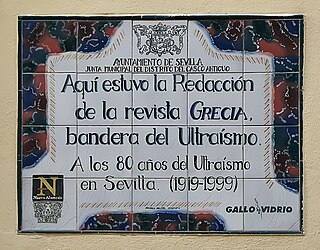 Cover of Sur, 1952 | |
| Categories | Literary |
|---|---|
| Format | Magazine |
| First issue | 1931 |
| Final issue | 1992 |
| Country | Argentina |
| Based in | Buenos Aires |
| Language | Spanish |

Sur was a literary magazine published in Buenos Aires between 1931 and 1992.
 Cover of Sur, 1952 | |
| Categories | Literary |
|---|---|
| Format | Magazine |
| First issue | 1931 |
| Final issue | 1992 |
| Country | Argentina |
| Based in | Buenos Aires |
| Language | Spanish |

Sur was a literary magazine published in Buenos Aires between 1931 and 1992.
Sur was first published in 1931, [1] [2] with the assistance of a multidisciplinary team of collaborators. Its founder and main backer was Victoria Ocampo, [2] and it was supported intellectually by the Spanish philosopher José Ortega y Gasset. Many of the earliest editions of Sur carry the colophon of Ortega's Revista de Occidente . Notable contributors and sometime editors included Jorge Luis Borges, H.A. Murena, José Bianco, Raimundo Lida, Adolfo Bioy Casares and Borges' Spanish brother-in-law Guillermo de Torre. [3] The last issue was published in 1992. [1] [4]

Jorge Francisco Isidoro Luis Borges Acevedo was an Argentine short-story writer, essayist, poet and translator regarded as a key figure in Spanish-language and international literature. His best-known works, Ficciones (transl. Fictions) and El Aleph, published in the 1940s, are collections of short stories exploring motifs such as dreams, labyrinths, chance, infinity, archives, mirrors, fictional writers and mythology. Borges's works have contributed to philosophical literature and the fantasy genre, and have had a major influence on the magic realist movement in 20th century Latin American literature.

Ramona Victoria Epifanía Rufina Ocampo was an Argentine writer and intellectual. Best known as an advocate for others and as publisher of the literary magazine Sur, she was also a writer and critic in her own right and one of the most prominent South American women of her time. Her sister was Silvina Ocampo, also a writer. In 1970, she was nominated for the Nobel Prize in Literature by Argentine writer Miguel Alfredo Olivera.

José Ortega y Gasset was a Spanish philosopher and essayist. He worked during the first half of the 20th century while Spain oscillated between monarchy, republicanism, and dictatorship. His philosophy has been characterized as a "philosophy of life" that "comprised a long-hidden beginning in a pragmatist metaphysics inspired by William James, and with a general method from a realist phenomenology imitating Edmund Husserl, which served both his proto-existentialism and his realist historicism, which has been compared to both Wilhelm Dilthey and Benedetto Croce."
Modernismo is a literary movement that took place primarily during the end of the nineteenth and early twentieth century in the Spanish-speaking world, best exemplified by Rubén Darío, who is known as the father of Modernismo. The term Modernismo specifically refers to the literary movement that took place primarily in poetry. This literary movement began in 1888 after the publication of Rubén Darío's Azul.... It gave Modernismo a new meaning. The movement died out around 1920, four years after the death of Rubén Darío. In Aspects of Spanish-American Literature, the author writes (1963),
Modernismo influences the meaning behind words and the impact of poetry on culture. Modernismo, in its simplest form, is finding the beauty and advances within the language and rhythm of literary works.

Leonor Fanny "Norah" Borges Acevedo, was an Argentine visual artist and art critic, member of the Florida group, and sister of the Argentine writer Jorge Luis Borges.

Emir Rodríguez Monegal, born in Uruguay, was a scholar, literary critic, and editor of Latin American literature. From 1969 to 1985, Rodríguez Monegal was professor of Latin American contemporary literature at Yale University. He is usually called by his second surname Emir R. Monegal or Monegal.

Argentine literature, i.e. the set of literary works produced by writers who originated from Argentina, is one of the most prolific, relevant and influential in the whole Spanish speaking world, with renowned writers such as Jorge Luis Borges, Julio Cortázar, Leopoldo Lugones and Ernesto Sábato.
"The House of Asterion" is a short story by Argentine writer Jorge Luis Borges. The story was first published in 1947 in the literary magazine Los Anales de Buenos Aires and republished in Borges's short story collection The Aleph in 1949. It is based on the Greek myth of Theseus and the Minotaur and is told from the perspective of Asterion, the Minotaur.
Martín Fierro was an Argentine literary magazine which appeared from February 1924 to 1927. It was one of the leading avant-garde magazines in the country.

José Manuel Donoso Yáñez, known as José Donoso, was a Chilean writer, journalist and professor. He lived most of his life in Chile, although he spent many years in self-imposed exile in Mexico, the United States and Spain. Although he had left his country in the sixties for personal reasons, after 1973 he said his exile was also a form of protest against the dictatorship of Augusto Pinochet. He returned to Chile in 1981 and lived there until his death.

Latin American literature consists of the oral and written literature of Latin America in several languages, particularly in Spanish, Portuguese, and the indigenous languages of Latin America. It rose to particular prominence globally during the second half of the 20th century, largely due to the international success of the style known as magical realism. As such, the region's literature is often associated solely with this style, with the 20th century literary movement known as Latin American Boom, and with its most famous exponent, Gabriel García Márquez. Latin American literature has a rich and complex tradition of literary production that dates back many centuries.
Mundo Nuevo was an influential Spanish-language periodical, being a monthly revista de cultura dedicated to new Latin American literature. Sponsored by the Ford Foundation, the magazine was founded by Emir Rodríguez Monegal in Paris, France, in 1966 and distributed worldwide. Monegal edited it until 1968 and resigned after a five-part installation in the New York Times that revealed the Congress for Cultural Freedom, a source of funding for the magazine, was a front for the CIA. In fact, it was started as a successor of another Spanish language magazine of the Congress, namely Cuadernos. Mundo Nuevo stopped in 1971 after 58 issues.

Los Contemporáneos can refer to a Mexican modernist group, active in the late 1920s and early 1930s, as well as to the literary magazine which served as the group's mouthpiece and artistic vehicle from 1928 to 1931. In a way, they were opposed to stridentism.
Bilingual Review Press is an American publishing house specialising in the publication of scholarly and literary works by Hispanic and Latino American authors and researchers. It was founded in 1973 as the publisher of The Bilingual Review/La revista bilingüe, a new academic and literary journal with a focus on Spanish-English bilingualism, bilingual studies and Hispanic literature that was first issued in 1974. Under the imprint name Bilingual Press/Editorial Bilingüe the press also publishes and distributes book titles by or about Hispanic and Latin American authors, covering literary fiction, poetry as well as non-fiction titles relating to Chicano and Latin American studies. Bilingual Press publishes from 8 to 10 titles annually, with an accumulated back catalogue of more than 150 titles under the imprint in both English and Spanish as well as some bilingual editions. The publisher is also a distributor of related titles from other presses, as of 2008 numbering over a thousand releases.
Alberto Augusto Valdivia Baselli is a Peruvian poet, writer, essayist, literary scholar, and specialist in Peruvian and Latin American Philosophy and culture.
José Luis Gómez Martínez is a professor emeritus of Spanish at the University of Georgia. Essayist and literary critic, his research into the theory of the essay, along with his work on Hispanic thought and Latin American fiction helped push literary boundaries and open up new lines of thinking within and outside of academia. During his professional career José Luis Gómez won several awards for his scholarly contributions, including the prestigious Guggenheim Memorial Foundation Fellowship (1984–1985), the Albert Christ-Janer Award (1988), named Professor of the Year by the AATSP-GA, the 1989 Sturgis Leavitt Prize. In 2000 he was elected Membro Correspondente da Academia Brasileira de Filosofia.
Nosotros was a cultural magazine published in Buenos Aires, Argentina. It was in circulation between 1907 and 1943. The magazine was a very significant publication in the country and enjoyed high levels of popularity and circulation not only in Argentina but also in other Latin American countries.

Revista Contemporánea was a literary and cultural magazine which was published in the period 1875–1907 in Madrid, Spain. The magazine was the first publication in Spain which introduced German and French thought.
Revista de Occidente is a cultural magazine which has been in circulation since 1923 with some interruptions. It is based in Madrid, Spain, and is known for its founder, José Ortega y Gasset, a Spanish philosopher.

Grecia was a literary magazine which was published from 1918 to 1920 in Spain. Its subtitle was Revista Decenal de Literatura. Later it was redesigned as Revista de literatura. It was a traditionalist as reflected in its title and modernist publication in the early years, but later adopted an avant-garde approach and became the flagship of the ultraísmo.